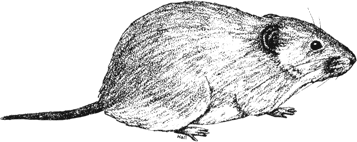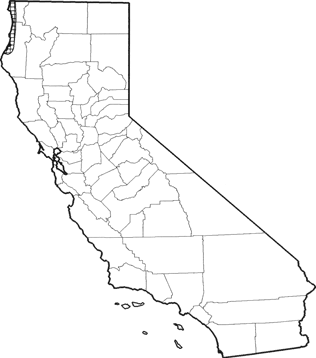
Townsend's Vole
Distribution, Abundance, and Seasonality
In California, Townsend's vole is found in coastal Humboldt and Del Norte cos. It is abundant in valley foothill riparian, wet meadow, and pasture habitats, and it is common in fresh and saline emergent wetlands, croplands, grasslands, and early successional stages of many forest habitats.

Range Map
Specific Habitat Requirements
Feeding: Feeds on grass, sedge, and rush stems, seeds, bulbs, roots, and cattail stems. Feeds on ground surface, digging out tubers, roots, and plant stems. Runway tunnels are lined with cut green vegetation similar to other microtines. Other foods (e.g., bulbs) also may be found in abundance, concealed in runways.
Cover: Prefers dense herbaceous growth, although occasionally found in brushy areas. Burrow is excavated in soft soil. Good swimmer and diver, and readily enters water when pursued (Maser et al. 1981).
Reproduction: A nest of dry grass is made in burrow. In Oregon, in winter, with high water tables, may locate nests on the surface, on a high point, or on hummock (Maser et al. 1981).
Water: Probably requires drinking water.
Pattern: Most common in low-lying areas. Prefers dense cover of sedges, grasses, or emergent aquatic vegetation.
Species Life History
Activity Patterns: Active year-round. Mostly nocturnal, but sometimes active throughout the day.
Seasonal Movements / Migration: None.
Home Range: Home range in British Columbia averaged 900 m? (8360 ft?) for males and 500 m? (4645 ft?) for females (Cornely and Verts 1988). Densities ranged up to 1320 per ha (519 per ac) (Boonstra and Krebs 1978).
Territory: No data found.
Reproduction: Breeds primarily from March to September, but may breed year-round in lowland areas. Gestation period is 21-24 days (MacFarlane and Taylor 1982). Litter sizes average 4-7 (range 2-10), and young are altricial. At least 2 litters per yr. Large voles are able to breed in winter (Boonstra and Krebs 1978). High densities of adults result in lower survival of juveniles, and slower growth rates.
Niche: Predators probably include various mustelids, foxes, coyotes, bobcats, hawks, and owls. Outcompetes M. oregoni, reducing its density (Sullivan and Krebs 1981).
Sources & References
California Department of Fish and Game, 1999.
California's Wildlife, Sacramento, CA.
Written by: P. Brylski, reviewed by: H. Shellhammer, edited by: R. Duke, J. Harris, S. Granholm
Boonstra, R. 1978. Effect of adult Townsend voles (Microtus townsendii) on survival of young. Ecology 59:242-248. Bonnstra, R., and C. J. Krebs. 1978. Pitfall trapping of Microtus townsendii. J. Mammal. 59:136-148. Cornely, J. E., and B. J. Verts. 1988. Microtus townsendii. Mammal. Species No. 325. 9pp. Goertz, J. W. 1964. Habitats of three Oregon voles. Ecology 45:846-848. Ingles, L. G. 1965. Mammals of the Pacific states. Stanford Univ. Press, Stanford, CA. 506pp. Krebs, C. J., I. Wingate, J. LeDuc, J. A. Redfield, M. Taitt, and R. Hilborn. 1976. Microtus population biology: dispersal in fluctuating populations of M. townsendii. Can. J. Zool. 54:79-95. MacFarlane, J. D., and J. M. Taylor. 1982. Pregnancy and reproductive performance in the Townsend's vole, Microtus townsendii (Bachman). J. Mammal. 63:168-173. Maser, C., B. R. Mate, J. F. Franklin, and C. T. Dyrness. 1981. Natural history of Oregon coast mammals. Pac. Northwest For. And Range Exp. Sta., USDA, For. Serv., Gen. Tech. Rep., PNW-133. 496pp. Sullivan, T. P., and C. J. Krebs. 1981. Microtus population biology: demography of M. oregoni in southwestern British Columbia. Can. J. Zool. 59:2092-2102.
California Animal Facts | California's Wildlife